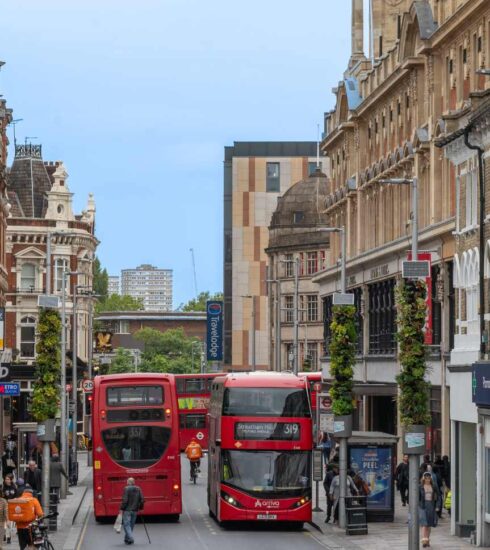Liveability Redefined: How Urban Design Shapes Community in Vancouver
- Jackie De Burca
- November 20, 2024
As Vancouver faces a significant urban transformation, driven by the implementation of Bill 47 in June 2024, the city has an unprecedented opportunity to redefine the nature of urban living. This legislation, which mandates the reworking of city planning to accommodate more residents on less land, has paved the way for a shift towards multiplex housing near transportation corridors1. In the face of a forecasted population growth of 30,000 new residents per year by 2041, totalling 1.2 million, with an estimated need for over 500,000 new dwellings1, the role of urban design has become increasingly crucial in shaping environments where people can thrive and foster a sense of community and togetherness.
Key Takeaways
- Vancouver’s urban transformation presents an opportunity to redefine urban living while maintaining neighbourhood character.
- Urban design plays a vital role in creating environments that foster a sense of community and togetherness.
- The shift towards multiplex housing near transportation corridors aims to accommodate population growth and housing needs.
- Sustainable urban planning practices, such as strategic infill and densification, are crucial in addressing the city’s growth.
- Enhancing social connections and reducing isolation are key priorities for creating livable communities in Vancouver.
Introduction to Urban Design in Vancouver
Vancouver’s urban design principles focus on creating liveable neighbourhoods with vibrant public spaces that promote walkability and strong community engagement2. The city’s planners play a crucial role in developing strategies that balance increased density with quality of life, ensuring the city’s growth aligns with the needs and expectations of its residents.
Overview of Urban Design Principles
Urban design in Vancouver places a strong emphasis on fostering social connections, as research has shown that the lack of social ties is linked to premature death, increased rates of disease, and higher rates of mental illness2. The Vancouver Foundation’s studies have highlighted concerns about social isolation, particularly among high-rise residents, underscoring the importance of incorporating community-focused elements into the city’s urban landscape.
Importance of Community Focus
Vancouver’s urban design philosophy is characterised by a constitutional need for “peace, order, and good government,” contrasting with the American ethos of “freedom and the pursuit of happiness.”2 This approach prioritises the collective wellbeing of the community, with a focus on creating public spaces that bring people together and encourage social interaction.
The Role of Planners in Urban Development
The city’s urban design history is marked by initiatives like mixed-use, medium-density redevelopment in the 1960s and the conversion of Granville Island into a cultural and shopping zone by the federal government2. Vancouver’s planners are tasked with balancing these innovative approaches with the need to maintain the city’s unique character and ensure that new developments seamlessly integrate with the existing urban fabric.
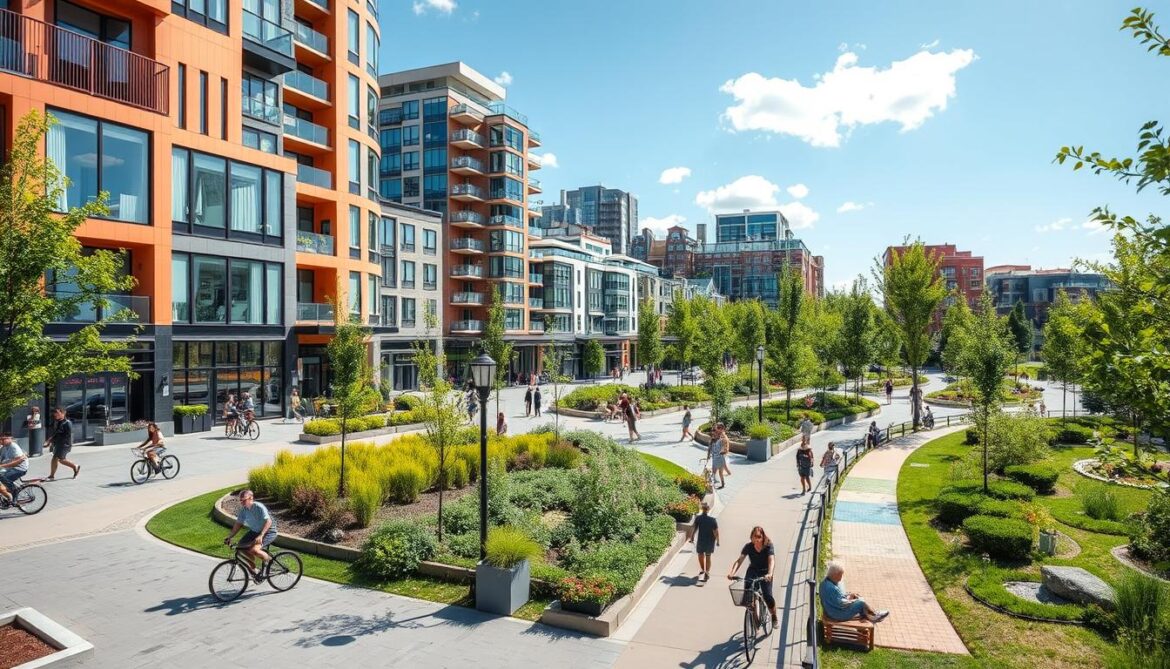
| Sub-Area | Residential & Non-Residential Uses | Minimum Job Space | Parks & Open Space |
|---|---|---|---|
| 6B (Plaza of Nations) | 1.8 million square feet | 350,000 square feet | 2.5 acres |
| 6C | 2.1 million square feet | 220,000 square feet | – |
| 10C | Maximum of 900,000 square feet | Minimum of 100,000 square feet | – |
| 6D | Maximum of 900,000 square feet | – | – |
The urban morphology of Vancouver has been influenced by three significant land deals: the amalgamation of municipalities in the 1920s, the construction of the Lion’s Gate Bridge initiated by the Guinness brewing family, and the sale of 240 acres to Hong Kong industrialist Li Ka Shing2.
“Vancouver is the only major city in North America without a freeway within its boundaries due to a citizen’s revolt in the late 1960s led by University of British Columbia architecture professors.”
The Impact of Urban Design on Community Life
Urban design in Vancouver has a profound influence on the city’s community life. The municipal approach prioritises creating public spaces that foster social interaction and community engagement3. Enhancing walkability and accessibility is a key focus, with wide sidewalks, grass boulevards, and pedestrian-friendly streetscapes3. However, research suggests that high-rise residents are less likely to know their neighbours’ names and have fewer social interactions compared to those in detached homes3. This highlights the need for thoughtful design solutions that promote community cohesion in dense urban environments.
Creating Public Spaces for Engagement
Vancouver’s urban planners recognise the importance of public spaces that bring residents together4. Community plans act as roadmaps, guiding positive change and development in neighbourhoods across the city4. The Spaces to Thrive policy provides a strategic framework for City-owned and City-supported social infrastructure, ensuring these spaces are accessible and inclusive4. Additionally, the Greenest City Fund offers grants to community-generated sustainability projects, fostering grassroots engagement4.
Enhancing Walkability and Accessibility
Pedestrian-friendly streetscapes are a hallmark of Vancouver’s urban design3. The city’s approach emphasises slower speeds in urban areas, aligning with the Safety in Numbers strategy, which has been shown to enhance transportation safety35. Spatial network analysis of Metro Vancouver’s neighbourhoods suggests that a higher density of buildings with moderate height, distributed among parcels of varied sizes, can positively impact economic vitality and housing affordability5. Furthermore, the intensity and diversity of the urban tree canopy are important factors in predicting active accessibility and social diversity5.
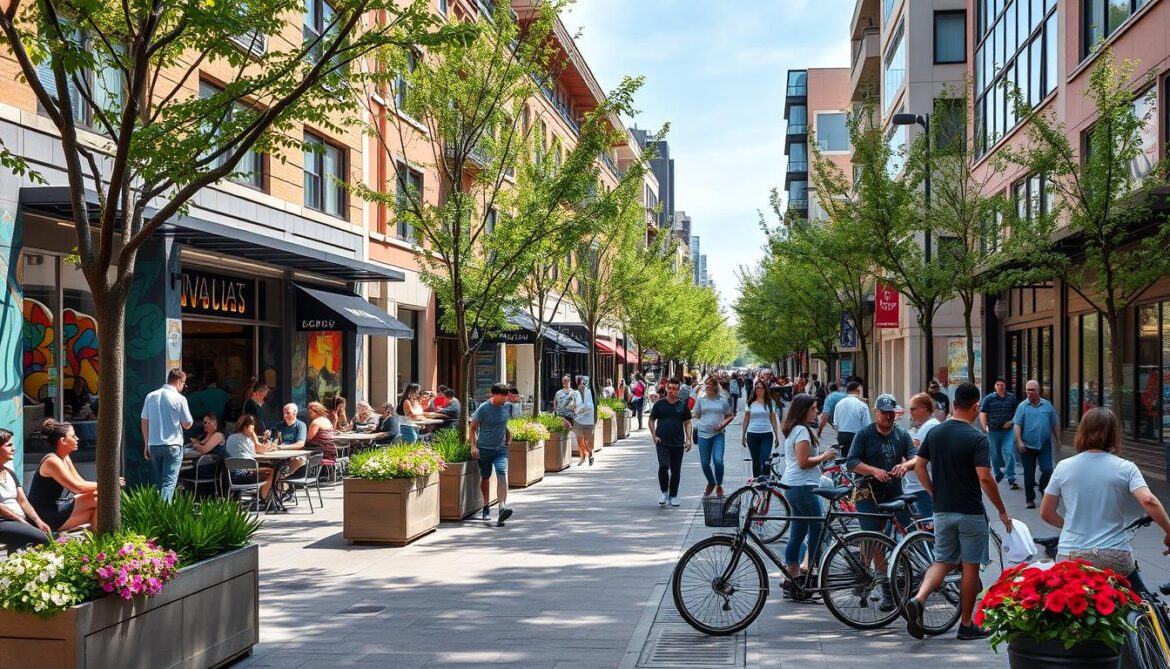
By creating vibrant public spaces and prioritising pedestrian-friendly design, Vancouver’s urban planners are shaping a community that fosters social inclusion and engagement345. These efforts are crucial in addressing the challenges of high-density living and ensuring the city’s residents have ample opportunities to connect and thrive.
| Livability Metric | Correlation with Urban Form Intensity |
|---|---|
| Economic Vitality | Positive |
| Housing Affordability | Positive |
| Social Diversity | Positive |
| Active Accessibility | Positive |
“By creating vibrant public spaces and prioritising pedestrian-friendly design, Vancouver’s urban planners are shaping a community that fosters social inclusion and engagement.”
Vancouver’s commitment to community-focused urban design is evident in its efforts to enhance walkability, foster social inclusion, and engage residents in the planning process345. These strategies are crucial in creating a liveable, sustainable, and socially vibrant city for the future.
Alexandra Steed: A Leader in Urban Design
In the realm of urban design, Alexandra Steed has emerged as a prominent figure shaping the future of cities6. Her firm, Alexandra Steed Urban, specialises in masterplanning and innovative urban solutions that prioritise community well-being and sustainable development. With the upcoming launch of their Vancouver office in 2024, Steed’s expertise is poised to contribute significantly to the evolving landscape of the city.
Background of Alexandra Steed Urban
Alexandra Steed, a visionary in the field of urban design, founded her eponymous firm in 20156. With a focus on biophilic design, the company’s work is aimed at enhancing human health and well-being in the built environment6. Steed’s team of urban designers, planners, and architects specialise in crafting masterplans and implementing innovative urban solutions that address the challenges facing modern cities.
Vancouver Office Launch in 2024
The expansion of Alexandra Steed Urban to Vancouver signifies the growing importance of expert urban design in the city’s development7. With a commitment to creating vibrant, liveable communities, the firm’s services are likely to contribute to Vancouver’s transformation, addressing challenges such as increasing density while maintaining the city’s unique character.
Services Offered by the Firm
Alexandra Steed Urban’s portfolio encompasses a wide range of urban design services, including masterplanning, public realm design, and community engagement6. The firm’s holistic approach to urban design aims to create spaces that foster social interaction, encourage active lifestyles, and promote environmental sustainability.
| Service | Description |
|---|---|
| Masterplanning | Comprehensive urban design strategies that shape the long-term vision for a city or district. |
| Public Realm Design | Designing vibrant and accessible public spaces that enhance community engagement. |
| Community Engagement | Facilitating collaborative workshops and dialogues to ensure the needs of local residents are met. |
With the upcoming launch of their Vancouver office, Alexandra Steed Urban is poised to make a significant impact on the city’s urban design landscape, contributing to the creation of more liveable, sustainable, and community-focused urban environments.
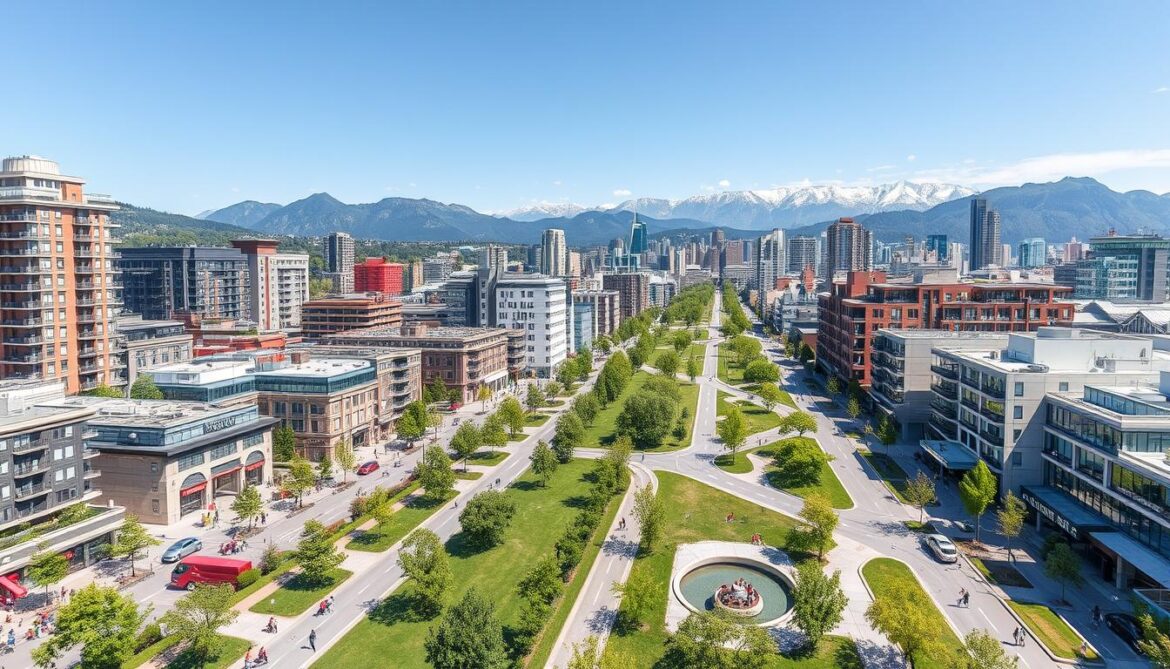
Sustainable Practices in Urban Design
Vancouver has embraced sustainable practices in its urban design, aligning with the city’s commitment to environmental leadership8. The Greenest City Action Plan aims to reduce the city’s ecological footprint by 33% of 2006 levels, with a strong focus on green infrastructure and eco-friendly transportation solutions9.
Green Infrastructure and Its Benefits
Vancouver’s urban design is renowned for its integration of nature and urban vitality, a concept known as “Vancouverism.”8 The city’s green infrastructure, such as parks, green roofs, and urban forests, provides numerous benefits, including improving air quality, reducing urban heat island effects, and enhancing biodiversity8. These sustainable practices contribute to the city’s overall resilience and liveability.
Eco-friendly Transportation Solutions
Sustainable transportation is a key priority in Vancouver’s urban design. The city focuses on creating communities that prioritize walking, cycling, and public transit to minimize dependence on private vehicles9. This approach aligns with the Vancouver Plan, which aims to make the city more livable, affordable, and sustainable9. By encouraging eco-friendly transportation, Vancouver aims to reduce greenhouse gas emissions and promote a healthier, more active lifestyle for its residents.
Vancouver’s commitment to sustainable urban design sets an example for other growing cities. Through the integration of green infrastructure and eco-friendly transportation solutions, the city is shaping a future that prioritizes environmental sustainability, community wellbeing, and a high quality of life.

“Vancouver is known for its ongoing planning projects that solidify its reputation as one of the most liveable cities globally.”9
Case Studies: Successful Urban Design Projects
Vancouver has witnessed the revitalisation of several urban neighbourhoods through innovative design projects that have enhanced community life. The redevelopment of the iconic Woodward’s site stands out as a prime example, transforming a once-abandoned building into a vibrant mixed-use complex. The project spanned10 2.32 acres and encompassed a total of10 1,073,715 square feet of space, breathing new life into the area.
The Woodward’s redevelopment was not without its challenges, however. The municipal government acquired the property in10 2003 for C$5 million, while the provincial government had purchased it10 two years earlier for C$22 million. The project attracted10 more than ten initial responses to the request for qualifications, with10 four finalists eventually submitting proposals. Ultimately10, three development teams provided their plans, with architect Henriquez receiving10 C$50,000 from developer Gillespie to put together a proposal.
Another successful urban design project in the region is Surrey’s Grandview Heights, a suburban development that seamlessly integrates residential, retail, and office uses while emphasising walkability and access to amenities. This11 2.3-acre site features11 92 rental live/work units above 200,000 square feet of retail space, as well as11 three levels of underground parking with 520 retail and 121 residential parking stalls. The project’s strategic location near the Canada Line transit system has contributed to an estimated11 ridership of more than 136,000 people per day in June 2011.
These case studies provide valuable lessons for future urban design projects in Vancouver and beyond. While the Woodward’s redevelopment faced challenges related to property acquisition and public consultation, it ultimately transformed a neglected site into a thriving mixed-use community. Similarly, the Grandview Heights development in Surrey demonstrates the benefits of integrating diverse land uses and prioritising sustainable transportation options. These projects underscore the importance of community-focused design in driving urban revitalisation and creating vibrant, liveable neighbourhoods.
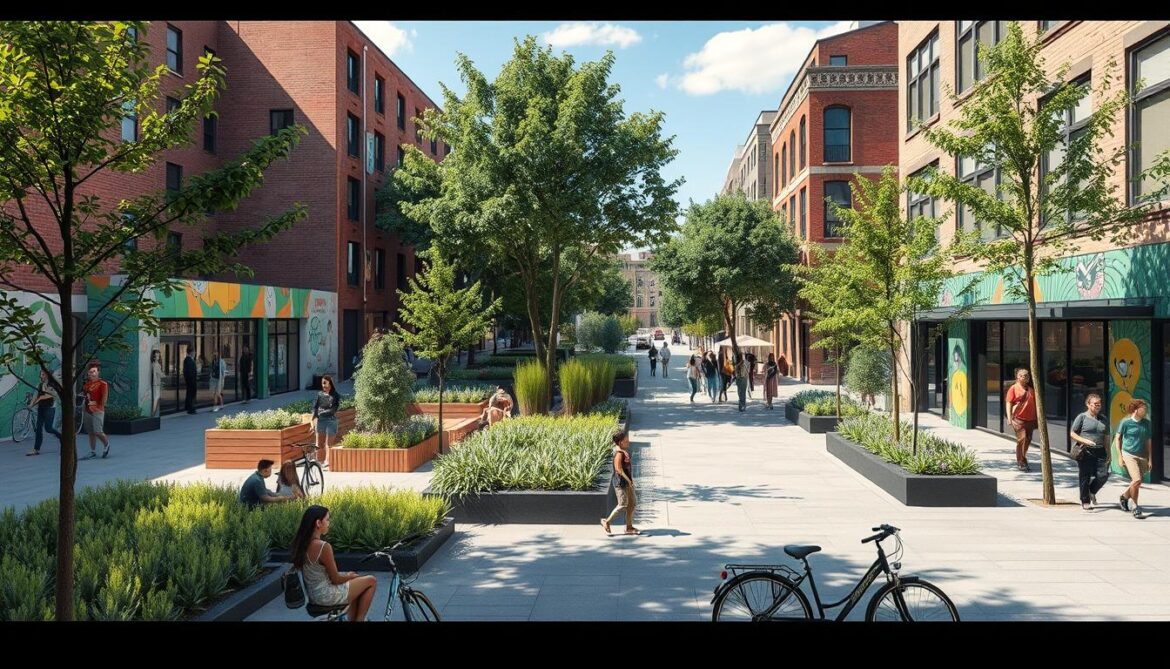
“These projects underscore the importance of community-focused design in driving urban revitalisation and creating vibrant, liveable neighbourhoods.”
Community Involvement in Urban Design
Participatory planning and community-led design are integral to Vancouver’s approach to urban development. The city emphasises engaging residents in the planning process and conducting collaborative design workshops to ensure that urban projects reflect the needs and desires of the local community12. This community-focused strategy is crucial for maximising benefits, minimising negative impacts, and achieving stakeholder satisfaction12.
Engaging Residents in the Planning Process
The city recognises that people affected by decisions have a right to be involved in the process, and that public contributions should influence the final outcome12. Engagement processes are carefully designed to target different groups and stages, ensuring inclusivity and transparent communication12. Residents are invited to participate in surveys, focus groups, public meetings, planning workshops, and advisory committees, allowing them to actively shape the future of their communities13.
Benefits of Collaborative Design Workshops
By involving community members in the design process, Vancouver’s urban planners can create holistic, amenity-rich developments that cater to the unique needs of local citizens13. This collaborative approach helps build a shared vision for the city’s future, fostering a sense of ownership and investment among residents13. The results can be seen in successful projects like Southeast False Creek, the River District, and Oakridge Centre Mall, where community input has positively influenced the planning and design13.
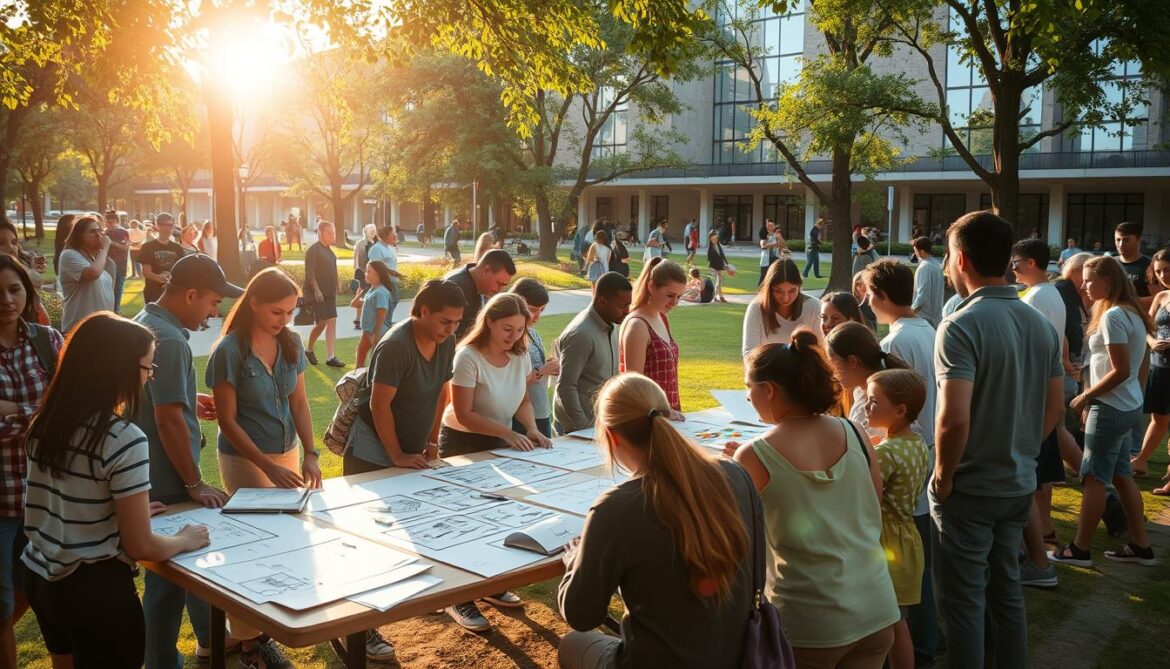
“Engaging with local city hall and actively participating in shaping Vancouver’s urban design can contribute to the city’s status as one of the world’s most livable cities.”13
The Role of Technology in Urban Design
Technology is playing an increasingly pivotal role in shaping the future of urban design in Vancouver. Smart city initiatives are being implemented across the city to enhance the quality of urban living and promote sustainability14. Infrastructure Canada’s Smart Cities Challenge has offered up to $50 million in funding to communities that develop innovative technological solutions to improve the lives of their residents14. These advancements are transforming the way citizens interact with their built environment and empowering them to have a more active voice in the urban planning process.
Smart City Initiatives in Vancouver
Vancouver is at the forefront of smart city technology, leveraging digital tools to address key urban challenges14. Following the 2012 Hurricane Sandy, AT&T provided charging stations and roaming coverage in New York City as part of their disaster response initiatives, demonstrating how technology can support communities in times of crisis14. Similarly, Christchurch, New Zealand, received an IBM Smarter Cities grant after the 2010-2011 earthquakes, leading to the formation of a non-profit organisation called the Sensing City Trust that harnesses technology to build urban resilience14. Vancouver’s Resilience Team is collaborating on developing a full-scale prototype of the Neighbour Hub by Fall 2018, a community-driven initiative that aims to provide energy, water, and communications independent of the city’s existing infrastructure.
Digital Tools for Community Input
In addition to smart city initiatives, Vancouver is also leveraging digital platforms to gather more meaningful community feedback on urban design projects15. Involving residents in the design process ensures the final space meets their expectations and fosters a sense of ownership15. Furthermore, collaborative efforts in placemaking projects lead to more sustainable and successful outcomes, as the community’s needs and priorities are deeply integrated into the design15. By utilising digital tools, urban planners can reach a wider audience and gather more diverse perspectives, resulting in urban spaces that truly cater to the diverse needs of the community.
Technology is revolutionising the way we approach urban design, enabling more responsive, sustainable, and community-driven solutions14. The UK Technology Strategy Board estimated that global private investment in technologies related to disaster management would surpass $300 billion by 2030, highlighting the growing importance of integrating technology into urban planning14. As Vancouver continues to embrace smart city initiatives and digital community engagement platforms, the city is poised to redefine the future of urban living, where technology and community come together to create thriving, resilient, and inclusive urban environments.
Urban Design and Affordability
Addressing affordability is a key challenge in Vancouver’s urban design. The city is working to balance development with housing needs, implementing strategies for inclusive housing solutions16. However, concerns about gentrification and displacement persist, requiring careful consideration in urban design and policy decisions.
Balancing Development with Housing Needs
The construction of the Georgia Viaduct in Vancouver led to the erasure of Hogan’s Alley, a once-thriving Black neighbourhood16. Zoning laws in West Vancouver previously prohibited individuals of African or Asian descent from residing there unless employed as domestic workers16. Urban renewal programs in the mid-20th century resulted in the uprooting and displacement of entire communities16. Affordable housing projects commonly come with unintended consequences, such as the displacement of existing residents and pricing out the very people they are meant to assist16.
Strategies for Inclusive Housing Solutions
Bill 47’s allowance for multiplexes on single-family lots aims to increase housing density and diversity16. Vancouver’s mode share for transit is at 20%, the highest on the west coast17. One in five new housing units are near SkyTrain stations in Vancouver17. However, housing values have increased while area incomes have not, leading to affordability challenges17. The Vancouver region is considered one of the most challenging in terms of affordability due to housing insecurity and transportation costs17.
There are initiatives in place such as anti-displacement toolkits, renter protections (rental-only zoning, rate-of-change bylaws, short term rental bylaws), community land trusts, regulatory flexibility, and financial tools to address affordable housing development17. Planners are urged to prioritise maintaining healthy building fabric and integrating affordable housing into existing communities without disruption16.
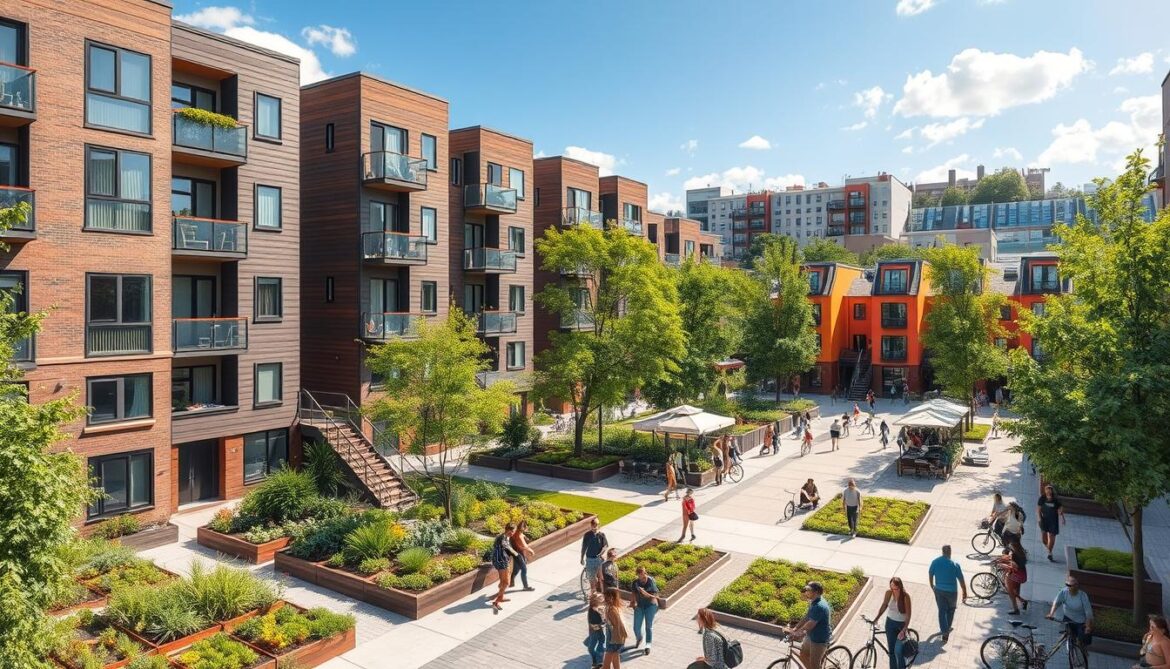
“Zoning policies, when used thoughtlessly or with profit-oriented motives, can become a force of structural violence, amplifying inequality under the guise of protection and care.”16
Research demonstrates that communities with strong social bonds experience lower crime rates as residents share a sense of responsibility and mutual care16. Certain urban planning initiatives, such as Vancouver’s Broadway Plan and Transit-Oriented Planning mandates, have led to the displacement of communities under the pretext of renewal16.
Future Trends in Vancouver's Urban Design
As Vancouver continues to evolve, its urban design is adapting to meet the challenges of the future. The city is at the forefront of urban innovation, pioneering sustainable building practices, community-focused design, and smart city initiatives that are transforming the way its residents live, work, and interact18.
Innovations on the Horizon
Vancouver is striving to become a zero-emission city, with green building design principles such as energy-efficient construction becoming standard practices18. The city also embraces mixed-use developments and higher density in strategic locations, aimed at creating a diverse and inclusive housing market18. Furthermore, Vancouver actively involves residents in decision-making through participatory planning initiatives, fostering a sense of community ownership and community evolution18.
The use of data-driven approaches allows for continuous monitoring and improvement of urban systems and infrastructure, enabling Vancouver to stay at the forefront of future city planning18. The city is also at the leading edge of implementing smart mobility solutions, such as integrated public transit, bicycle sharing, and electric vehicle infrastructure, all aimed at reducing carbon emissions and enhancing connectivity18.
Predictions for Community Transformation
Vancouver’s commitment to sustainable development, affordable housing, public spaces, and smart city innovations positions it as a global leader in urban design18. Over the last 10 years, the city has funded 2,500 new or upgraded social housing units with the assistance of development contributions, and the same contributions have also facilitated the creation of 3,000 licensed childcare spaces19.
Looking ahead, Vancouver’s urban design is expected to continue evolving, with a greater emphasis on mixed-use developments, public spaces, and liveable, connected neighbourhoods. These trends aim to address issues of social isolation while promoting environmental sustainability, ultimately transforming the city’s communities for the better18.
| Initiative | Description |
|---|---|
| Urban Design Panel | Vancouver’s Urban Design Panel reviews all civic building projects, bridges, roads, parks, transit systems, and civic buildings, among others, advising City Council and staff on development proposals and policies19. |
| Urban Design Awards | Urban Design Awards in Vancouver have been acknowledging projects that demonstrate visionary thinking and support design excellence since 201419. |
“Vancouver’s urban design is evolving to meet the challenges of the future, with a focus on sustainability, community engagement, and smart city solutions.”
Challenges Faced in Urban Design
As Vancouver continues to evolve and redefine its urban landscape, the city faces several complex challenges in its design and development. At the forefront are concerns surrounding gentrification and the need to balance the demands of urban development with the preservation of affordable housing and vibrant communities20.
One of the key issues is the city’s housing affordability crisis. With a housing affordability ratio that has risen from 5.3 in 2005 to a staggering 12 today20, Vancouver is struggling to provide accessible and sustainable living options for its residents. The concentration of developable land in the hands of fewer than 40% of households20 has exacerbated the problem, leading to a steady exodus of young people and an ageing population20.
Navigating the complex planning policy landscape also presents significant challenges for urban designers and city officials. Decisions must carefully weigh the needs of diverse stakeholders, including developers, community members, and environmental advocates. The recent example of the DP-2019-00395 development project in Grandview-Woodland illustrates the delicate balancing act, as city council had to choose between adhering to the community plan or responding to public opinion21.
In addressing these challenges, innovative approaches and collaboration between planners, developers, and community members will be crucial. Strategies such as revitalizing urban areas, increasing green spaces, and promoting alternative transportation22 can help mitigate the impacts of gentrification and create more livable, sustainable cities. By embracing the principles of sustainable urban design, Vancouver can strive to build a future that balances the needs of its diverse population and preserves the city’s unique character22.
Addressing Gentrification Concerns
The rapid development and transformation of Vancouver’s urban landscapes have led to concerns over gentrification, where rising property values and rent prices threaten to displace long-term residents. Addressing these concerns requires a multifaceted approach that prioritizes affordable housing, community engagement, and the preservation of cultural identity20.
Navigating Bureaucratic Obstacles
Urban design in Vancouver is further complicated by the intricate web of bureaucratic processes and policies that govern land use, zoning, and development approvals. Navigating these obstacles requires a deep understanding of the planning policy landscape and the ability to engage effectively with various stakeholders, including government agencies, community groups, and industry partners21.
“The negative consequences of Vancouver’s current regulatory approach may become irreversible over a 20-year period, causing the city to regulate the life out of itself.”20
As Vancouver continues to evolve, embracing innovative solutions and fostering collaborative partnerships will be crucial in overcoming the challenges of urban development and shaping a more inclusive, sustainable, and livable city. By addressing gentrification concerns and navigating bureaucratic obstacles, urban designers can help ensure that Vancouver’s growth benefits all its residents, both present and future.
Conclusion: The Future of Vancouver's Urban Community
Vancouver’s urban design continues to evolve, shaping the future of the city’s communities23. The ongoing focus on creating liveable, sustainable, and inclusive urban spaces reflects the city’s commitment to enhancing quality of life for all residents23. Community engagement remains crucial in this process, with a call to action for residents to participate in shaping their urban environment24. The future of Vancouver’s urban community depends on collaborative efforts to address challenges and embrace innovative design solutions.
The Ongoing Evolution of Urban Design
Vancouver’s urban design landscape is constantly transforming, driven by the need to create vibrant, equitable, and resilient communities23. The city’s population growth23, as well as the increasing diversity of its residents23, have necessitated a fresh approach to urban planning and design25. Sustainable development, smart technology, and inclusive community engagement are shaping the future of Vancouver’s urban spaces.
Call to Action for Community Engagement
The success of Vancouver’s urban design initiatives relies heavily on the active participation of its residents24. By empowering communities to co-create their urban environments, the city can address longstanding issues of gentrification, displacement, and social inequity24. Initiatives like participatory budgeting and community-led design offer residents a meaningful voice in shaping their neighbourhoods, fostering a sense of ownership and collective responsibility24. As Vancouver’s urban community continues to evolve, it is crucial that all stakeholders, from policymakers to residents, work together to build a more liveable, sustainable, and equitable future.
FAQ
What are the key urban design principles in Vancouver?
How does urban design impact community life in Vancouver?
What is the significance of Alexandra Steed Urban’s expansion to Vancouver?
How does Vancouver’s urban design incorporate sustainable practices?
What are some successful urban design projects in Vancouver and nearby cities?
How does community involvement play a role in Vancouver’s urban design process?
What is the role of technology in Vancouver’s urban design?
How is Vancouver addressing the challenge of affordability in urban design?
Source Links
- Living up or living apart – https://vancouver.ca/files/cov/living-up-or-living-apart.pdf
- PLAC1602_01-80.in – https://placesjournal.org/assets/legacy/pdfs/new-urbanism-the-vancouver-model.pdf
- Urban Design – Dom’s Plan B Blog – https://domz60.wordpress.com/tag/urban-design/
- Building liveable, sustainable, and inclusive communities – https://vancouver.ca/people-programs/building-community.aspx
- Urban form and livability: socioeconomic and built environment indicators | Buildings & Cities – https://journal-buildingscities.org/articles/10.5334/bc.82
- 14 Patterns of Biophilic Design – https://www.terrapinbrightgreen.com/reports/14-patterns/
- B2B: Untapped Potential: Quality Public Realm for Moscow – https://www.themoscowtimes.com/2013/10/28/b2b-untapped-potential-quality-public-realm-for-moscow-a29011
- Urban planning, sustainable zoning, and development – https://vancouver.ca/home-property-development/planning-zoning-development.aspx
- Planning a liveable, sustainable city – https://vancouver.ca/home-property-development/urban-planning.aspx
- PDF – https://casestudies.uli.org/wp-content/uploads/2014/04/WoodwardsPDF.pdf
- PDF – https://casestudies.uli.org/wp-content/uploads/2014/05/The-Rise-PDF.pdf
- How we do community engagement – https://vancouver.ca/your-government/how-we-do-community-engagement.aspx
- Shape Your City – Get Involved in the Community Planning Process – https://mlacanada.com/newsfeed/shape-your-city-get-involved-in-the-community-planning-process
- Smart Technology, and Smarter Communities – Spacing Vancouver – https://spacing.ca/vancouver/2018/05/28/smart-tech-smart-communities/
- Enhancing Urban Design with Placemaking Strategies – https://www.philmyrick.com/sb/best-practices-for-integrating-placemaking-in-urban-design/
- When Care Becomes Control: The Hidden Violence of Urban Planning – Spacing Vancouver – https://spacing.ca/vancouver/2024/11/18/when-care-becomes-control-the-hidden-violence-of-urban-planning/
- The Vancouver Context – Mpact – https://www.mpactmobility.org/blog/affordability-and-displacement-the-vancouver-context/
- Future City of Urban Design in Vancouver: Shaping tomorrow – By Side. – https://www.theside.ca/blog-posts/future-city-of-urban-design-in-vancouver-shaping-tomorrow
- YCH – Civics Toolbox – Fact Sheet 4 – Planning and Urban Design – https://vancouver.ca/files/cov/fact-sheet-4-planning-urban-design.pdf
- Vancouver’s Housing Challenges Are a Cautionary Tale for Successful, Well-Managed Cities – https://www.discoursemagazine.com/p/vancouvers-housing-challenges-are
- Urban Design Panel Issues Thinly Veiled Rebuke Of Vancouver City Council’s Annoying Decision – https://cityduo.wordpress.com/2019/08/13/urban-design-panel-issues-thinly-veiled-rebuke-of-vancouver-city-councils-annoying-decision/
- Contrasting Urban Design Challenges: British Columbia vs. Tehran – https://www.linkedin.com/pulse/contrasting-urban-design-challenges-british-columbia-vs-r-zand-gdduf
- PDF – https://radar.brookes.ac.uk/radar/file/810d53e6-dc91-4441-8681-797bbb8d5965/1/Vancouver city profile – 2018 – Carpenter Hutton.pdf
- When Care Becomes Control: The Hidden Violence of Urban Planning (Erick Villagomez, Spacing Vancouver) – https://cityhallwatch.wordpress.com/2024/11/18/care-control-hidden-violence-urban-planning-villagomez-spacing/
- The future of Northeast False Creek – https://vancouver.ca/home-property-development/northeast-false-creek.aspx







